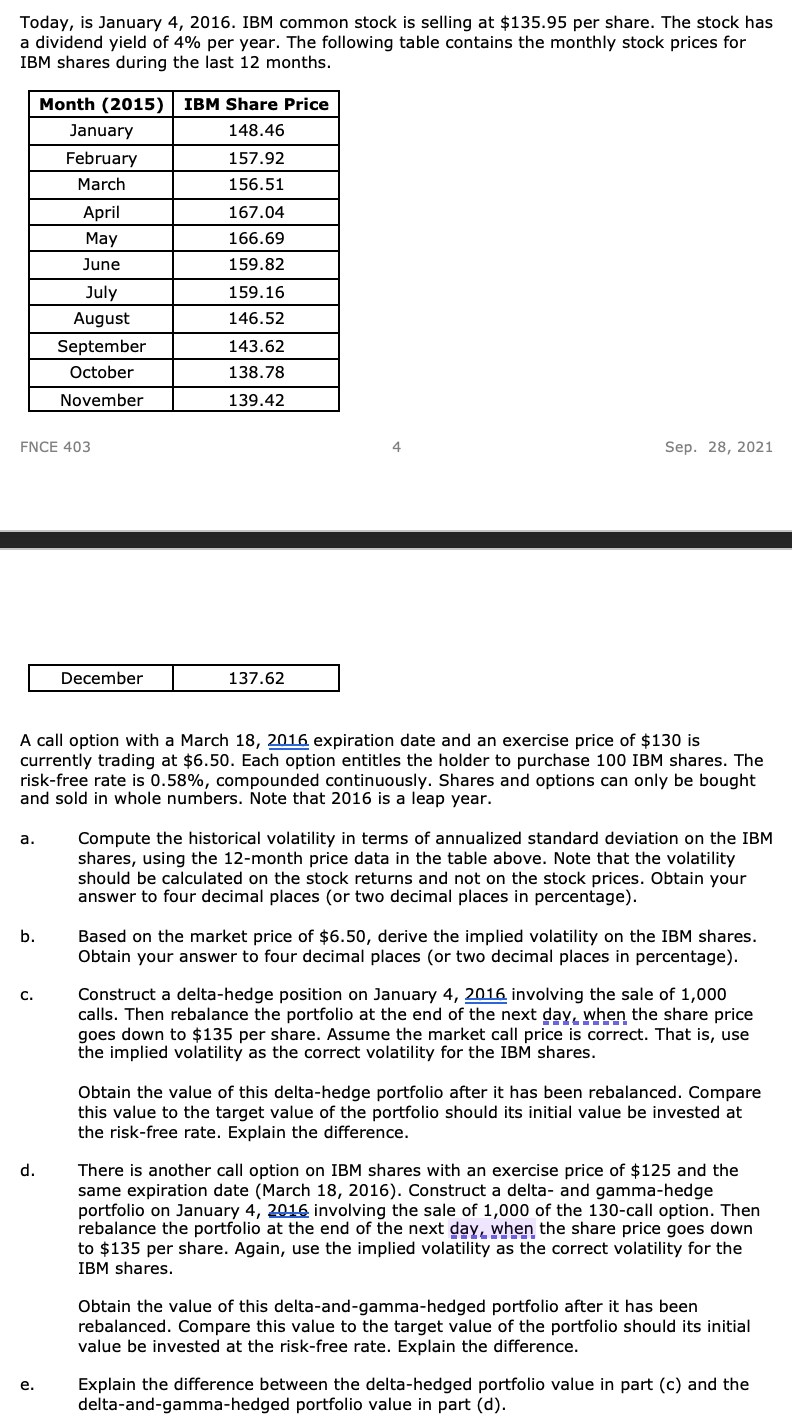Answered step by step
Verified Expert Solution
Question
1 Approved Answer
This question has been causing me a lot of trouble. Will leave a great review if someone can help me solve it. Thank you!! Today,

This question has been causing me a lot of trouble. Will leave a great review if someone can help me solve it. Thank you!!
Today, is January 4, 2016. IBM common stock is selling at $135.95 per share. The stock has a dividend yield of 4% per year. The following table contains the monthly stock prices for IBM shares during the last 12 months. Month (2015) | IBM Share Price January 148.46 February 157.92 March 156.51 April 167.04 May 166.69 June 159.82 July 159.16 August 146.52 September 143.62 October 138.78 November 139.42 FNCE 403 4 Sep. 28, 2021 December 137.62 A call option with a March 18, 2016 expiration date and an exercise price of $130 is currently trading at $6.50. Each option entitles the holder to purchase 100 IBM shares. The risk-free rate is 0.58%, compounded continuously. Shares and options can only be bought and sold in whole numbers. Note that 2016 is a leap year. a. Compute the historical volatility in terms of annualized standard deviation on the IBM shares, using the 12-month price data in the table above. Note that the volatility should be calculated on the stock returns and not on the stock prices. Obtain your answer to four decimal places (or two decimal places in percentage). b. Based on the market price of $6.50, derive the implied volatility on the IBM shares. Obtain your answer to four decimal places (or two decimal places in percentage). C. Construct a delta-hedge position on January 4, 2016 involving the sale of 1,000 calls. Then rebalance the portfolio at the end of the next day, when the share price goes down to $135 per share. Assume the market call price is correct. That is, use the implied volatility as the correct volatility for the IBM shares. Obtain the value of this delta-hedge portfolio after it has been rebalanced. Compare this value to the target value of the portfolio should its initial value be invested at the risk-free rate. Explain the difference. d. There is another call option on IBM shares with an exercise price of $125 and the same expiration date (March 18, 2016). Construct a delta- and gamma-hedge portfolio on January 4, 2015 involving the sale of 1,000 of the 130-call option. Then rebalance the portfolio at the end of the next day, when the share price goes down to $135 per share. Again, use the implied volatility as the correct volatility for the IBM shares. Obtain the value of this delta-and-gamma-hedged portfolio after it has been rebalanced. Compare this value to the target value of the portfolio should its initial value be invested at the risk-free rate. Explain the difference. e. Explain the difference between the delta-hedged portfolio value in part (c) and the delta-and-gamma-hedged portfolio value in part (d). Today, is January 4, 2016. IBM common stock is selling at $135.95 per share. The stock has a dividend yield of 4% per year. The following table contains the monthly stock prices for IBM shares during the last 12 months. Month (2015) | IBM Share Price January 148.46 February 157.92 March 156.51 April 167.04 May 166.69 June 159.82 July 159.16 August 146.52 September 143.62 October 138.78 November 139.42 FNCE 403 4 Sep. 28, 2021 December 137.62 A call option with a March 18, 2016 expiration date and an exercise price of $130 is currently trading at $6.50. Each option entitles the holder to purchase 100 IBM shares. The risk-free rate is 0.58%, compounded continuously. Shares and options can only be bought and sold in whole numbers. Note that 2016 is a leap year. a. Compute the historical volatility in terms of annualized standard deviation on the IBM shares, using the 12-month price data in the table above. Note that the volatility should be calculated on the stock returns and not on the stock prices. Obtain your answer to four decimal places (or two decimal places in percentage). b. Based on the market price of $6.50, derive the implied volatility on the IBM shares. Obtain your answer to four decimal places (or two decimal places in percentage). C. Construct a delta-hedge position on January 4, 2016 involving the sale of 1,000 calls. Then rebalance the portfolio at the end of the next day, when the share price goes down to $135 per share. Assume the market call price is correct. That is, use the implied volatility as the correct volatility for the IBM shares. Obtain the value of this delta-hedge portfolio after it has been rebalanced. Compare this value to the target value of the portfolio should its initial value be invested at the risk-free rate. Explain the difference. d. There is another call option on IBM shares with an exercise price of $125 and the same expiration date (March 18, 2016). Construct a delta- and gamma-hedge portfolio on January 4, 2015 involving the sale of 1,000 of the 130-call option. Then rebalance the portfolio at the end of the next day, when the share price goes down to $135 per share. Again, use the implied volatility as the correct volatility for the IBM shares. Obtain the value of this delta-and-gamma-hedged portfolio after it has been rebalanced. Compare this value to the target value of the portfolio should its initial value be invested at the risk-free rate. Explain the difference. e. Explain the difference between the delta-hedged portfolio value in part (c) and the delta-and-gamma-hedged portfolio value in part (d)Step by Step Solution
There are 3 Steps involved in it
Step: 1

Get Instant Access to Expert-Tailored Solutions
See step-by-step solutions with expert insights and AI powered tools for academic success
Step: 2

Step: 3

Ace Your Homework with AI
Get the answers you need in no time with our AI-driven, step-by-step assistance
Get Started


